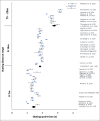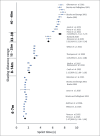Testing distance characteristics and reference values for ice-hockey straight sprint speed and acceleration. A systematic review and meta-analyses
- PMID: 37398950
- PMCID: PMC10286618
- DOI: 10.5114/biolsport.2023.122479
Testing distance characteristics and reference values for ice-hockey straight sprint speed and acceleration. A systematic review and meta-analyses
Abstract
Ice-hockey requires high acceleration and speed sprint abilities, but it is unclear what the distance characteristic is for measuring these capabilities. Therefore, this systematic meta-analysis aims to summarize the sprint reference values for different sprint distances and suggest the appropriate use of ice-hockey straight sprint testing protocols. A total of 60 studies with a pooled sample of 2254 males and 398 females aged 11-37 years were included. However, the pooled data for women was not large enough to permit statistical analysis. The sprint distance used for measuring the reported acceleration and speed was between 4-48 m. Increased test distance was positively associated with increased speed (r = 0.70) and negatively with average acceleration (r = -0.87). Forward skating sprint speed increases with the measured distance up to 26 m and do not differ much from longer distance tests, while acceleration decreases with a drop below 3 m/s at distances 15 m and longer. The highest acceleration (5.89 m/s2 peak, 3.31 m/s2 average) was achieved in the shortest distances up to 7 m which significantly differs from 8-14 m tests. The highest speed (8.1 m/s peak, 6.76 m/s average) has been recorded between 26-39 m; therefore, distances over 39 m are not necessary to achieve maximum speed. Considering match demands and most reported test distances, 6.1 m is the recommended distance for peak acceleration and 30 m for peak speed. The sprint time, acceleration, and speed of each individual and the number of skating strides should be reported in future studies.
Keywords: Anaerobic; Condition; Exercise; Sport training; Testing.
Copyright © Biology of Sport 2023.
Conflict of interest statement
The authors declare no conflict of interest directly relevant to the content of this article.
Figures





References
-
- Douglas AS, Kennedy CR. Tracking In-Match Movement Demands Using Local Positioning System in World-Class Men’s Ice Hockey. J Strength Cond Res. 2020; 34:639–46. - PubMed
-
- Schulze S, Laudner KG, Delank K-S, Brill R, Schwesig R. Reference data by player position for an ice hockey-specific complex test. Applied Sciences. 2021; 11:280.
-
- Farlinger CM, Kruisselbrink LD, Fowles JR. Relationships to skating performance in competitive hockey players. J Strength Cond Res. 2007; 21:915–22. - PubMed
-
- Vigh-Larsen JF, Haverinen MT, Panduro J, Ermidis G, Andersen TB, Overgaard K, et al. . On-Ice and Off-Ice Fitness Profiles of Elite and U20 Male Ice Hockey Players of Two Different National Standards. J Strength Cond Res. 2020; 34:3369–76. - PubMed
-
- Vigh-Larsen JF, Beck JH, Daasbjerg A, Knudsen CB, Kvorning T, Overgaard K, et al. . Fitness Characteristics of Elite and Subelite Male Ice Hockey Players: A Cross-Sectional Study. J Strength Cond Res. 2019; 33:2352–60. - PubMed
Publication types
LinkOut - more resources
Full Text Sources
